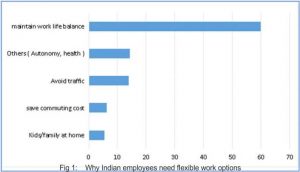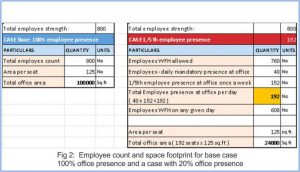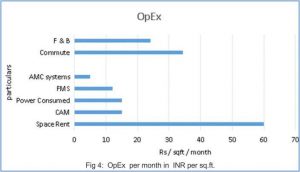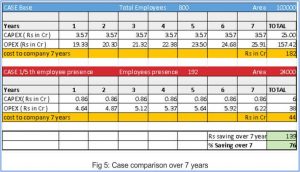The global outbreak of the novel CoronaVirus has affected not just the way we live but also redefined work as we know it. While social distancing and self-quarantining have become the de-facto manner of living for now, the forced work-from-home situation has impacted professional lifestyles. The concept itself is not new. Previously, opted for by employees only on occasion, it seems that the remote workplace is here to stay. Milind Mantravadi and Prof Vishal Garg share their insights on this ‘new normal’
With the work-from-home feature set to become the new normal, the realty sector has to brace itself for a disruption in two areas – the office space, with lesser work areas and the residential segment, where new dedicated work spaces need to be carved out. Over the last few years, trends in real estate have been largely dictated by millennials’ involvement in housing investment. They directly affected apartment sizes by opting for smaller and more affordable homes. Affordability was viewed in terms of a lower investment cost as well as lower maintenance costs. In addition to this, factors such as the ease with which smaller properties get home loan approvals and can be resold in case of a decision to relocate – swung in favour of small homes. And now, along with size being the deciding factor, it is increasingly being seen that location of residential projects matters too. Millennials are either preferring locations closer to their workplaces or farther away with an option to work from home. It’s not difficult to see why. Housing and public infrastructure for transportation and other basic needs hasn’t kept pace with the mushrooming of high concentration of Tech-Parks in cities such as Bengaluru, Hyderabad, Chennai, Noida, Pune and others, leading to perennial traffic jams and poor quality of life.
A Case For Working From Home
It turns out that the number one reason for opting for a work-from-home option by Indian employees is a ‘work-life’ balance. Over 3/4th of 1200 respondents surveyed by a job portal Shine.com revealed a preference for a work-from-home option with nearly 60% of them saying they wanted to maintain a ‘work-life’ balance.

According to LinkedIn’s Global Talent Trends 2019 report, which surveyed 5,000 talent acquisition and HR professionals around the world, 36% of women and 29% of men said that work flexibility really matters when they make job decisions. Another study conducted in the US (State of Remote Work 2019 by Owl Labs) showed that employees were even willing to take pay cuts in order to work from home. The study reported that 34% of polled workers would be willing to take a 5% cut; 24% would take a 10% cut; and 20% would take a cut larger than 10%.Interestingly enough, companies such as Dell, Sodexo, Humana and others have shown that flexible working arrangements are not just a company policy catering to employee demand, but from an employer-point of view, such arrangements also help in increasing productivity and attracting top talent.
Redesign And Dedicate Space
To facilitate a seamless experience of working from home, the inclusion of a dedicated workspace area within a home is necessary. According to an India Today report, there are a number of factors contributing to the tendency of shrinking Indian kitchens. One of them is the tendency of the current generation to use the services of cloud kitchens and preferring to order in or dine out. The fallout of this reduction in demand for kitchen and utility spaces, has paved the way instead for home offices. The challenge of designing dedicated home office spaces gets a tad more complex in the case of working couples where work spaces have to be provided for two individuals working simultaneously.
Such scenarios will also drive requirements essential to make the experience as seamless as working from an office. Demand for high speed, low-latency internet connectivity, data privacy, home office furniture, as well as thermal comfort and lighting as expected in any office will witness a surge. According to Avinash Suresh, Region Head – South, Birla Estates Pvt. Ltd, mere redesigning of home spaces is not enough. “Home designs of the future will need to be flexible enough to accommodate home offices, not merely through the addition of extra rooms or space but by adoption of innovative solutions like modularity of space within the house, offering common workspaces within the residential complex and including support services for working professionals like creches, canteens and so on,” he says.
Newer upcoming residential projects such as Birla Alokya in Bangalore have already incorporated community work spaces located within their master plan. Such plug and play environments within walking distance of homes that can be pre-booked through mobile apps seem to replicate an office-like atmosphere not just in terms of design layout but also where one can bounce ideas with like-minded folks.
How WFH Helps The Environment
As we marked the 50th anniversary of the annual Earth Day event this year, one of the most noticeable effects of the pandemic has been on climate change. A work-from-home situation arising out of this shutdown has been synonymous with an improvement in the environment. We are witnessing a sharp dip in air pollution, and significant increase in air quality level associated with reduction in carbon emissions. This has led to more sustainable operations. Not to mention immense savings for the employers too.
“Working from home at scale does bring many positives to the economy and the environment including enhancing productivity from (lack of) commute hours and traffic delays, reduced operating costs at office premises, significant CO2 emission reductions and so on,” says Jai Thampi, Senior Vice President, Strategy & Innovation at Schneider Electric, Home & Distribution Division. He goes on to add that on the flip side, one can expect higher energy and internet bandwidth consumption at homes in case of mass work-from-home behaviors. From the consumption point of view, with large numbers of employees working from home since the lockdown was enforced, data from the Department of Telecommunications has shown that India’s internet consumption rose by 13%. And fortunately, as per media reports, the additional strain has been met by most of the internet service providers successfully.
WFH: Employers’ Perspective
As per a recent report in the Business Insider, the pandemic has nudged companies such as TCS to transition into a new phase of their operating model where employees have to be in office only 25% of their time. Apparently this new secure borderless workspaces (SBWS) model will continue to stay even after the virus threat recedes. An obvious factor aiding the adoption of this model is the quantifiable saving gains to the company. In a similar bid to quantify the savings that will accrue in the case of an office space which has a reduced simultaneous physical employee presence, we performed a simple analysis (see Appendix for details) which revealed that there is a huge potential for saving of Capital Investment Cost (Capex) and Operational Expense Cost (Opex) to the tune of 76%.
Trends: What To Expect In An Office Space Now?
Architecture and design have always evolved to reflect social needs of the times. With gradual easing of the lockdown in certain sectors of the economy, the office space architectural design standards and existing benchmarks are set to evolve to distance physical proximity with other employees. Existing offices will explore possibilities to revise the space layout configurations which will result in either occupying a larger footprint to accommodate the social distancing criteria or exploring options to reduce direct employee presence at workspace.
A reflection of the pandemic-induced fears and subsequent safeguards is likely to be witnessed with strategically located hand sanitizers and sanitizing tunnels at critical entry and exits. There is a high likelihood of shifting away from finger touch-based access to facilities with touch-free access. Seating arrangements themselves ought to be reorganized to reflect lesser occupancy per net occupied floor area. However, with the introduction of employee shifts, it is likely to lead to an increased utilization rate, i.e, the average use of a space, often measured as a percentage of the total period that the space is available for use, such as during the organization’s business hours.
With the availability of collaborative tools that will allow for distanced interactions, huddle areas and conference rooms will also need to be redesigned to account for lesser occupancy. To allow for enough physical distance between elevator occupants, the sizes of the elevators (which will be called on demand in a touchless manner) themselves will see an increase. To supplement this, there may be a demand for installation of escalators and travelators. Similarly, in order to avoid face-to-face interactions and crossovers with others, uni circulation pathways are likely to be laid out.With the focus on respiratory well-being, a ventilation system which exceeds filtered fresh air intake is set to figure high on the design specification list. AC systems will be designed to avoid possible contamination to spread from one zone to another. One of the possibilities is the use of small AHUs serving smaller zones. Radiant cooling and displacement ventilation have a potential as they reduce the flow of air. There will be a call for an increased number of open spaces and enhanced fresh air into the hitherto closed air-conditioned workstations. Technology will drive washroom and housekeeping schedules with the use of automated gadgets. Workspaces and stationery will not only have to be minimal but also the interior surfaces will have to be such so as to discourage microbial settlement. There will also be the possibility of widespread use of phone applications for all employees and visitors that will help maintain and limit physical presence in corridors, lounges, cafeterias, elevators and other public spaces at real time.
Trends: What To Expect In A Home Office Now?
Anand Mahindra, Chairman of the Mahindra group recently put the spotlight on the work-from-home attire one adopts by confessing that he often wears lungis beneath his formal shirt. Millennials were never one to embrace formal office wear and with work from home becoming a norm, an informal sartorial sense only seems right. This is bound to be reflected in a shrinking wardrobe size and closet space making way for perhaps a larger study or office room. The space itself can perhaps be situated on another floor or located in such a way on the same floor so as to avoid distraction from domestic activities. To facilitate work breaks, break out areas such as terrace spills need to be accommodated in the design of residential spaces. Such open spaces can also double up as family casual sit-out decks. To ensure minimal external disturbances, the external windows, doors and walls will need to be insulated against sound. High speed internet connectivity, backed with UPS charging facility is a must. To attain optimum thermal and visual comfort, there should be a combination of glare-free natural light streaming in through windows as well as adequate electric lighting. The colours, surfaces and forms of the interiors ought to be specked for visual inspiration. In case of couples working simultaneously at home, a larger workspace and an extended work table is advisable. A plus would be a collapsible sound-proof booth to avoid distraction to the other whilst on a call. This can also be mitigated by aid of technology such as noise-cancelling headphones or by using the spill-over space alternatively. With the advent of ‘smart homes’, the entire residence can be provisioned to integrate smart kitchen appliances, child or infant monitoring, basic home automation and information systems to program and facilitate certain home chores that can be carried out automatically while working. With the six feet social distancing rule not going away in a hurry, the elevator systems, corridors, and community spaces in residential complexes too should be designed to avoid physical proximity at any time. This can be done either by making changes to the physical space design standards or through the use of active smart technology interventions which space out usage in real time.
Ravindra Shet, Director IoT, Samsung R&D Institute, Bengaluru, says that at Samsung, they have been working on SmartThings IoT for smart homes to prepare society for the future. “So, we were already ahead of the curve. Time will tell if COVID-19 hastens the change, as we have already witnessed corporates and new home buyers insisting on a home office, maybe even to specification. (Such) ..state-of-the-art smart home with home office as a managed service would also become an option for some users”.
Home In Office or Office In Home
With an office set up within the confines of a home, often the distinction between the two spaces gets blurred. Avinash Suresh draws our attention to laws and regulations that need to be in place when there is no line drawn between residential and commercial space in the traditional sense. He says that with the emergence of the home as the primary work place and the evolution of communication technology, it’s not just home design that needs to evolve to cater to this demand but even governmental policies are the need of the hour to enable the transition. “For example, the concept of a registered office being a predefined commercial space will no longer necessarily hold true. Every home office can potentially be a registered office or the society mail room may need to be the registered office for several businesses running out of home offices in an apartment complex,” says Avinash.
Conclusion
It is clear that architects, designers and even lawmakers will need to look at unique solutions for the office – whether it be at home or otherwise – with its ever burgeoning needs. Until now, company policies seemed to be driven by economics. With the impact of the current pandemic, there has been a forced shift in focus to employee well being. One that can be measured not only in terms of physical but also mental health. With the stay-at-home diktat translating into a work-from-home compulsion, sustainability in terms of lesser pollution, and reduced energy consumption seems to be the welcome collateral ‘damage’. And all this, without hurting the companies’ bottom lines (as seen in our hypothetical analysis in the Appendix below). Of course, there may be instances where employee productivity might dip only because of individual preferences or proclivity towards team work. While such scenarios have to be addressed adequately, the current overall situation provides a unique opportunity to improve the well being of employees, their families, reduce adverse environmental impact and still save money. It is interesting to watch how the realty sector will evolve in response to this opportunity.
About The Authors
Milind Mantravadi is an alumnus of IIITH, founding batch M.Tech ( IT in Building Science), after his degree in Architecture from Goa College of Architecture. He has been instrumental in initiating and instituting the post graduate course in Building sustainability and Technology, at the University School of Design under the aegis of The University of Mysore. Currently, he is the Founder & Principal of Green Matrix, a specialized consultancy that offers services in Sustainability and Technology Design for 5 star hotels, retail malls, ITES campuses and other residential projects. Milind has gained a deep understanding of sustainable urban development coupled with the successful overlap of smart technology and urban analytics to create solutions for smart buildings and cities of the future.

Vishal Garg is Professor and Head of the Center for IT in Building Science at IIIT Hyderabad. His current research interests are in the areas of smart homes, building energy simulation, and building automation. He teaches building automation and controls, energy simulation, and lighting design & technology. He holds a B.Tech. (Hons.) degree in Civil Engineering from MBM Engineering College, Jodhpur and a Ph.D. from the IIT Delhi. He was the founding president of Indian chapter of International Building Performance Simulation Association (IBPSA) and chaired the organizing committee of International Conference for Building Simulation-2015 and International Conference on Countermeasures to Urban Heat Islands (IC2UHI)-2019. He received the inaugural Arthur H. Rosenfeld Urban Cooling Achievement Award in 2018. He is Fellow of IBPSA, ISLE and IGBC.

(Facilitated and Edited By Sarita Chebbi)
Appendix
Calculations of Possible Employer Savings: Partial Presence vs. 100% Office Presence
We conducted an analysis of a hypothetical office space, 10,000 sq.meters that could conventionally seat a total of 800 employees. Two scenarios were considered – One, where there is 100% employee presence in office on all work days and another where there is only a 20% presence (assuming 40 employees come to office every day and 152 of them come once a week) (192 employees) on any given day. The reduced office presence translates to a one-time office commute per week for the employee.



Over a 7-year projection, we estimate quantified savings to the organisation in terms of capital investment cost (CapEx), operational expense cost (OpEx) and other travel-related costs. A reduced Capex to the employer by means of lesser foot-print, interior works and lower lease deposit can be taken. An accompanying reduction in Opex has also been estimated through reduced monthly commitment on space rental, common area maintenance, metered resource usage for electricity, air conditioning, water, facilities such as housekeeping, pantry and security, annual maintenance contract fees for equipment such as AC units, CCTV systems and furniture.

In 7 years, we estimate that savings of 76% can be expected to the employer when there is a reduced employee presence. This is apart from the benefits which will accrue to employees such as improved work-life balance, diminished commute fatigue and others. In this simple calculation, there are many other aspects that are not considered such as increase in cost to the employer for providing home infrastructure such as internet, WiFi, work-related furniture, office space rental and others, and increase in space per employee in the office. We understand from the existing studies that employees are happy to work from home due to the tangible benefits and are not concerned about additional expenses arising from a work-from-home situation.


